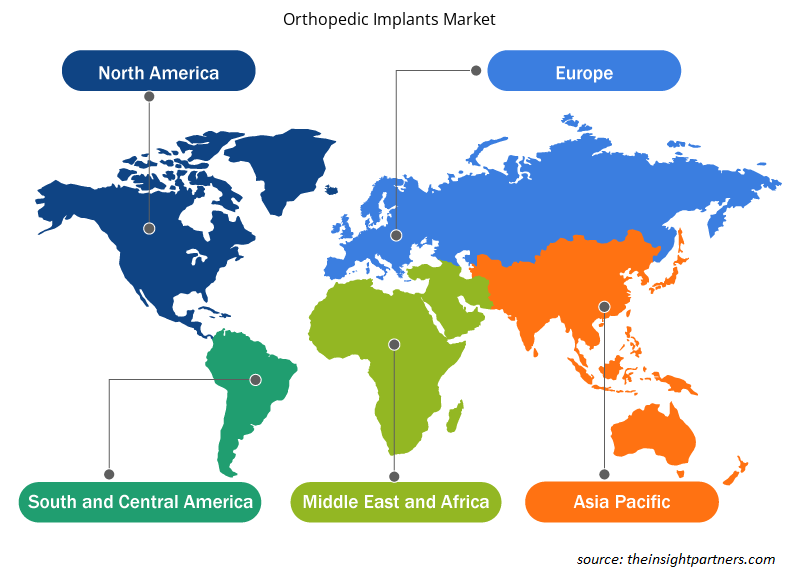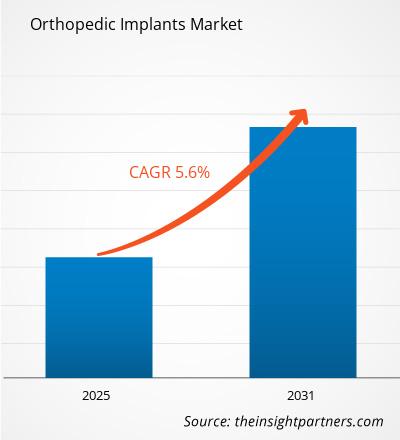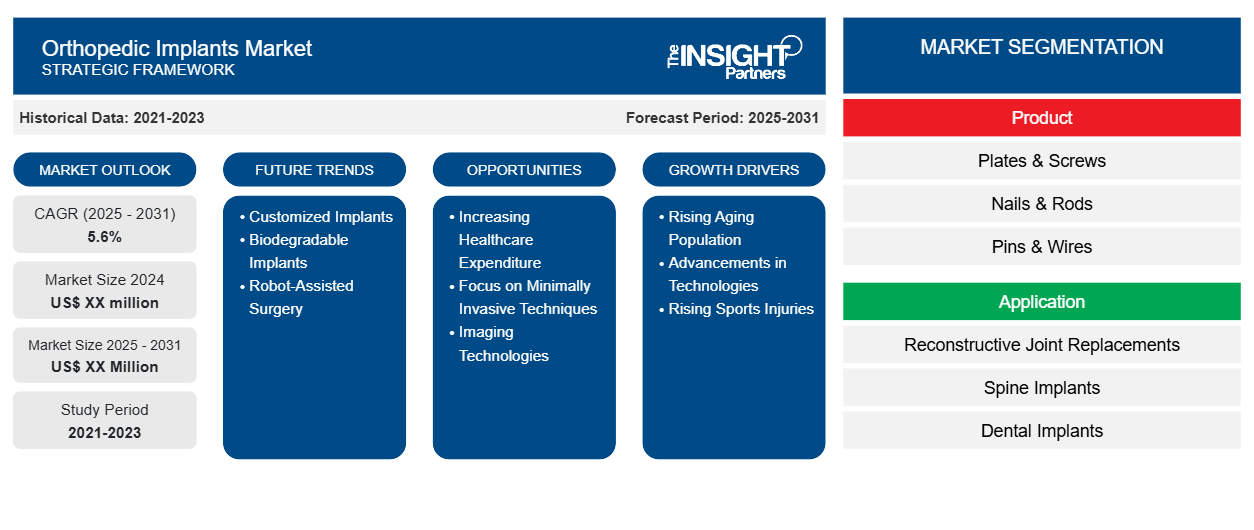Se espera que el mercado de implantes ortopédicos registre una CAGR del 5,6 % entre 2023 y 2031, con un tamaño de mercado que se expandirá de US$ XX millones en 2023 a US$ XX millones en 2031.
El informe está segmentado por producto (placas y tornillos, clavos y varillas, clavijas y alambres, otros). El informe presenta además un análisis basado en la aplicación (reemplazos reconstructivos de articulaciones, implantes de columna, implantes dentales, implantes para traumatismos, productos ortobiológicos, otros). Además, está segmentado en función del usuario final (hospitales, clínicas ortopédicas, centros quirúrgicos ambulatorios, otros). El análisis global se desglosa aún más a nivel regional y por países principales. El informe ofrece el valor en USD para el análisis y los segmentos anteriores.
Propósito del Informe
El informe Orthopedic Implants Market de The Insight Partners tiene como objetivo describir el panorama actual y el crecimiento futuro, los principales factores impulsores, los desafíos y las oportunidades. Esto proporcionará información a diversas partes interesadas del negocio, como:
- Proveedores/fabricantes de tecnología: Para comprender la dinámica cambiante del mercado y conocer las oportunidades potenciales de crecimiento, lo que les permitirá tomar decisiones estratégicas informadas.
- Inversionistas: Realizar un análisis exhaustivo de tendencias sobre la tasa de crecimiento del mercado, las proyecciones financieras del mercado y las oportunidades que existen en toda la cadena de valor.
- Órganos reguladores: Regular las políticas y vigilar las actividades del mercado con el objetivo de minimizar los abusos, preservar la confianza de los inversores y defender la integridad y la estabilidad del mercado.
Segmentación del mercado de implantes ortopédicos
Producto
- Placas y tornillos
- Clavos y varillas
- Pines y cables
- Otros
Solicitud
- Reemplazos reconstructivos de articulaciones
- Implantes de columna
- Implantes dentales
- Implantes Traumatológicos
- Ortobiológicos
- Otros
Usuario final
- Hospitales
- Clínicas ortopédicas
- Centros de cirugía ambulatoria
- Otros
Geografía
- América del norte
- Europa
- Asia-Pacífico
- América del Sur y Central
- Oriente Medio y África
Geografía
- América del norte
- Europa
- Asia-Pacífico
- América del Sur y Central
- Oriente Medio y África
Personalice este informe según sus necesidades
Obtendrá personalización en cualquier informe, sin cargo, incluidas partes de este informe o análisis a nivel de país, paquete de datos de Excel, así como también grandes ofertas y descuentos para empresas emergentes y universidades.
- Obtenga las principales tendencias clave del mercado de este informe.Esta muestra GRATUITA incluirá análisis de datos, desde tendencias del mercado hasta estimaciones y pronósticos.
Factores impulsores del crecimiento del mercado de implantes ortopédicos
- Aumento de la población envejecida: una población de edad avanzada en aumento en todo el mundo genera una mayor prevalencia de trastornos ortopédicos, lo que requiere reemplazos de articulaciones y dispositivos espinales para mejorar la movilidad.
- Avances en tecnologías: Las innovaciones en materiales y métodos de fabricación, como la impresión 3D y los implantes bioreabsorbibles, mejoran significativamente el rendimiento general y la durabilidad de los implantes ortopédicos para promover el crecimiento del mercado y un mejor resultado para los pacientes.
- Aumento de las lesiones deportivas: esta mayor participación en actividades deportivas y de fitness ha modificado la incidencia de las lesiones relacionadas con el deporte, que requieren implantes ortopédicos para un tratamiento y una recuperación adecuados. Por lo tanto, se está impulsando la expansión del mercado.
Tendencias futuras del mercado de implantes ortopédicos
- Implantes personalizados: La orientación al cliente hacia implantes ortopédicos personalizados está ganando impulso rápidamente, lo que proporcionaría un mejor ajuste, comodidad y rendimiento, estableciendo así mejores resultados de la cirugía.
- Implantes biodegradables: Los implantes ortopédicos bioabsorbibles están destinados a convertirse en la opción sustentable que evitará casos de reintervención; por lo tanto, lograr un comportamiento del consumidor consciente del medio ambiente impulsará la futura demanda del mercado.
- Cirugía Asistida por Robot: Con la integración de técnicas quirúrgicas en los procedimientos ortopédicos de cirugía asistida por robot comienzan a cambiar el panorama en términos de colocación precisa de implantes y tiempo de recuperación significativamente reducido.
Oportunidades de mercado para implantes ortopédicos
- Aumento del gasto en atención sanitaria: el aumento del gasto en atención sanitaria a nivel mundial, especialmente en los mercados emergentes, ayudará a las personas a obtener un mejor acceso a procedimientos e implantes ortopédicos avanzados, lo que conducirá al crecimiento del mercado y a una mejor atención al paciente.
- Enfoque en técnicas mínimamente invasivas: la creciente demanda de procedimientos quirúrgicos mínimamente invasivos brinda una oportunidad para desarrollar implantes innovadores para dichas aplicaciones, reduciendo así los tiempos de recuperación y la satisfacción del cliente.
- Tecnologías de imágenes: El advenimiento de tecnologías de imágenes avanzadas, como la resonancia magnética y la tomografía computarizada, ahora puede mejorar la planificación preoperatoria y, posteriormente, el diseño de implantes para mejorar los resultados y la seguridad de las intervenciones quirúrgicas en procedimientos ortopédicos.
Perspectivas regionales del mercado de implantes ortopédicos
Los analistas de Insight Partners explicaron en detalle las tendencias y los factores regionales que influyen en el mercado de implantes ortopédicos durante el período de pronóstico. Esta sección también analiza los segmentos y la geografía del mercado de implantes ortopédicos en América del Norte, Europa, Asia Pacífico, Oriente Medio y África, y América del Sur y Central.

- Obtenga datos regionales específicos para el mercado de implantes ortopédicos
Alcance del informe de mercado sobre implantes ortopédicos
| Atributo del informe | Detalles |
|---|---|
| Tamaño del mercado en 2023 | XX millones de dólares estadounidenses |
| Tamaño del mercado en 2031 | US$ XX millones |
| Tasa de crecimiento anual compuesta (CAGR) global (2023-2031) | 5,6% |
| Datos históricos | 2021-2022 |
| Período de pronóstico | 2024-2031 |
| Segmentos cubiertos | Por producto
|
| Regiones y países cubiertos | América del norte
|
| Líderes del mercado y perfiles de empresas clave |
|
Densidad de actores del mercado de implantes ortopédicos: comprensión de su impacto en la dinámica empresarial
El mercado de implantes ortopédicos está creciendo rápidamente, impulsado por la creciente demanda de los usuarios finales debido a factores como la evolución de las preferencias de los consumidores, los avances tecnológicos y una mayor conciencia de los beneficios del producto. A medida que aumenta la demanda, las empresas amplían sus ofertas, innovan para satisfacer las necesidades de los consumidores y aprovechan las tendencias emergentes, lo que impulsa aún más el crecimiento del mercado.
La densidad de actores del mercado se refiere a la distribución de las empresas o firmas que operan dentro de un mercado o industria en particular. Indica cuántos competidores (actores del mercado) están presentes en un espacio de mercado determinado en relación con su tamaño o valor total de mercado.
Las principales empresas que operan en el mercado de implantes ortopédicos son:
- Smith y Nephew Plc.
- Compañía: Zimmer Biomet Holdings, Inc.
- Corporación Stryker
- Johnson y Johnson (DePuy Synthes)
- Medtronic
Descargo de responsabilidad : Las empresas enumeradas anteriormente no están clasificadas en ningún orden particular.

- Obtenga una descripción general de los principales actores clave del mercado de implantes ortopédicos
Puntos de venta clave
- Cobertura integral: el informe cubre de manera integral el análisis de productos, servicios, tipos y usuarios finales del mercado de implantes ortopédicos, proporcionando un panorama holístico.
- Análisis de expertos: el informe se compila sobre la base de un profundo conocimiento de expertos y analistas de la industria.
- Información actualizada: El informe asegura relevancia comercial debido a su cobertura de información reciente y tendencias de datos.
- Opciones de personalización: este informe se puede personalizar para satisfacer los requisitos específicos del cliente y adaptarse adecuadamente a las estrategias comerciales.
Por lo tanto, el informe de investigación sobre el mercado de implantes ortopédicos puede ayudar a abrir camino para descifrar y comprender el escenario de la industria y las perspectivas de crecimiento. Si bien puede haber algunas preocupaciones válidas, los beneficios generales de este informe tienden a superar las desventajas.
- Análisis histórico (2 años), año base, pronóstico (7 años) con CAGR
- Análisis PEST y FODA
- Tamaño del mercado, valor/volumen: global, regional y nacional
- Industria y panorama competitivo
- Conjunto de datos de Excel
Informes recientes
Informes relacionados
Testimonios
Razón para comprar
- Toma de decisiones informada
- Comprensión de la dinámica del mercado
- Análisis competitivo
- Información sobre clientes
- Pronósticos del mercado
- Mitigación de riesgos
- Planificación estratégica
- Justificación de la inversión
- Identificación de mercados emergentes
- Mejora de las estrategias de marketing
- Impulso de la eficiencia operativa
- Alineación con las tendencias regulatorias





















 Obtenga una muestra gratuita para - Mercado de implantes ortopédicos
Obtenga una muestra gratuita para - Mercado de implantes ortopédicos